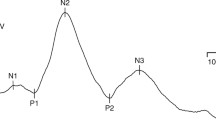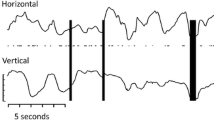Abstract
Purpose
Pre-term infants are at risk of abnormal visual development that can range from subtle to severe. The aim of this study was to compare flash VEPs in clinically stable pre-term and full-term infants at 6 months of age.
Methods
Twenty-five pre-term and 25 full-term infants underwent flash VEP testing at the age of 6 months. Monocular VEPs were recorded using flash goggles on a RETIscan system under normal sleeping conditions. Amplitude and peak time responses of the P2 component in the two eyes were averaged and compared between the two groups. Multiple regression analyses were performed to assess the relationship of the P2 responses with birth weight (BW) and gestational age (GA).
Results
At 6 months corrected age, pre-term infants had significantly delayed P2 peak times than full-term infants (mean difference: 10.88 [95% CI 4.00–17.76] ms, p = 0.005). Pre-term infants also showed significantly reduced P2 amplitudes as compared to full-term infants (mean difference: 2.36 [0.83–3.89] µV, p = 0.003). Although the regression model with GA and BW as fixed factors explained 20% of the variance in the P2 peak time (F2,47 = 5.98, p = .0045), only GA showed a significant negative relationship (β = −2.66, p = .003). Neither GA (β = 0.21, p = .28) nor BW (β = 0.001, p = .32) showed any relationship with P2 amplitude.
Conclusions
Our results demonstrate that, compared with full-term infants, clinically stable pre-term infants exhibit abnormal flash VEPs, with a delay in P2 peak time and a reduction in P2 amplitude. These findings support a potential dysfunction of the visual pathway in clinically stable pre-term infants as compared to full-term infants.



Similar content being viewed by others
References
Beck S, Wojdyla D, Say L et al (2010) The worldwide incidence of pre-term birth: a systematic review of maternal mortality and morbidity. Bull World Health Organ 88:31–38
Vogel JP, Chawanpaiboon S, Moller AB et al (2018) The global epidemiology of pre-term birth. Best Pract Res Clin Obstet Gynaecol 52:3–12
Leung MPS, Thompson B, Black J et al (2018) The effects of pre-term birth on visual development. Clin Exp Optom 101:4–12
Madan A, Jan JE, Good WV (2005) Visual development in pre-term infants. Dev Med Child Neurol 47:276–280
Arpino C, Compagnone E, Montanaro ML et al (2010) Pre-term birth and neurodevelopmental outcome: a review. Childs Nerv Syst 26:1139–1149
O’Connor AR, Wilson CM, Fielder AR (2007) Ophthalmological problems associated with pre-term birth. Eye 21(10):1254–1260
Cooke RWI, Foulder-Hughes L, Newsham D, Clarke D (2004) Ophthalmic impairment at 7 years of age in children born very pre-term. Arch Dis Child Fetal Neonatal Ed 89:F249–F253
Leijser LM, de Bruïne FT, Steggerda SJ et al (2009) Brain imaging findings in very pre-term infants throughout the neonatal period: part I. Incidences and evolution of lesions, comparison between ultrasound and MRI. Early Hum Dev 85:101–109
Taylor MJ, Saliba E, Laugier J (1996) Use of evoked potentials in pre-term neonates. Arch Dis Child 74:70–76
Hou C, Norcia AM, Madan A et al (2011) Visual cortical function in very low birth weight infants without retinal or cerebral pathology. Investig Ophthalmol Vis Sci 52:9091–9098
Placzek M, Mushin J, Dubowitz LMS (1985) Maturation of the visual evoked response and its correlation with visual acuity in pre-term infants. Dev Med Child Neurol 27:448–454
de Vries L (1996) Neurological assessment of the pre-term infant. Acta Paediatr 85:765–771
Eken P, van Nieuwenhuizen O, van der Graaf Y et al (1994) Relation between neonatal cranial ultrasound abnormalities and cerebral visual impairment in infancy. Dev Med Child Neurol 36:3–15
Feng JJ, Wang WP, Guo SJ et al (2013) Flash visual evoked potentials in pre-term infants. Ophthalmology 120:489–494
Feng JJ, Wang TX, Yang CH et al (2010) Flash visual evoked potentials at 2-year-old infants with different birth weights. World J Pediatr 6:163–168
Shepherd AJ, Saunders KJ, McCulloch DL, Dutton GN (1999) Prognostic value of flash visual evoked potentials in pre-term infants. Dev Med Child Neurol 41:9–15
Clarke MP, Mitchell KW, Gibson M (1997) The prognostic value of flash visual evoked potentials in the assessment of non-ocular visual impairment in infancy. Eye 11:398–402
Ekert PG, Keenan NK, Whyte HE et al (1997) Visual evoked potentials for prediction of neurodevelopmental outcome in pre-term infants. Neonatology 71:148–155
Kato T, Watanabe K (2006) Visual evoked potential in the newborn: does it have predictive value? Semin Fetal Neonatal Med 11:459–463
Sorensen LC, Greisen G (2009) The brains of very pre-term newborns in clinically stable condition may be hyperoxygenated. Pediatrics 124:e958–e963
World Health Organization (2018) Pre-term birth. Retrieved from https://www.who.int/news-room/fact-sheets/detail/pre-term-birth
Odom JV, Bach M, Brigell M, ISCEV standard for clinical visual evoked potentials: (2016 update) (2016) ISCEV standard for clinical visual evoked potentials:(2016 update). Documenta Ophthalmologica 133(1):1–9
Benavente I, Tamargo P, Tajada N et al (2005) Flash visually evoked potentials in the newborn and their maturation during the first six months of life. Doc Ophthalmol 110:255–263
R Core Team (2013). R: a language and environment for statistical computing. R Foundation for Statistical Computing, Vienna, Austria. http://www.R-project.org/
Wickham H (2016) ggplot2: elegant graphics for data analysis. Springer, New York
Armstrong RA (2013) Statistical guidelines for the analysis of data obtained from one or both eyes. Ophthalmic Physiol Opt 33:7–14
Saunders KJ, McCulloch DL, Shepherd AJ, Wilkinson AG (2002) Emmetropisation following pre-term birth. Br J Ophthalmol 86:1035–1040
Quinn GE, Dobson V, Kivlin J et al (1998) Prevalence of myopia between 3 months and 5 1/4 years in pre-term infants with and without retinopathy of prematurity. Ophthalmology 105:1292–1300
Choi MY, Park IK, Yu YS (2000) Long term refractive outcome in eyes of pre-term infants with and without retinopathy of prematurity: comparison of keratometric value, axial length, anterior chamber depth, and lens thickness. Br J Ophthalmol 84:138–143
Uprety S, Morjaria P, Shrestha JB, Shrestha GS, Khanal S (2017) Refractive status in nepalese pre-term and full-term infants early in life. Optom Vis Sci 94(10):957–964
Taylor NM, Jakobson LS, Maurer D, Lewis TL (2009) Differential vulnerability of global motion, global form, and biological motion processing in full-term and pre-term children. Neuropsychologia 47:2766–2778
Geldof CJA, Oosterlaan J, Vuijk PJ et al (2014) Visual sensory and perceptive functioning in 5-year-old very pre-term/very-low-birthweight children. Dev Med Child Neurol 56:862–868
Michalczuk M, Urban B, Chrzanowska-Grenda B, et al (2015) An influence of birth weight, gestational age, and apgar score on pattern visual evoked potentials in children with history of prematurity. Neural Plast 2015
Tsuneishi S, Casaer P (1997) Stepwise decrease in VEP latencies and the process of myelination in the human visual pathway. Brain Dev 19:547–551
Dietrich RB, Bradley WG, Zaragoza EJ IV et al (1988) MR evaluation of early myelination patterns in normal and developmentally delayed infants. Am J Roentgenol 150:889–896
Tobimatsu S, Celesia GG (2006) Studies of human visual pathophysiology with visual evoked potentials. Clin Neurophysiol 117:1414–1433
Funding
No funding was received for this research.
Author information
Authors and Affiliations
Corresponding author
Ethics declarations
Statement of human rights
All procedures in human participants were performed in accordance with the ethical standards of the Institutional Review Board of the Institute of Medicine, Tribhuvan University and with the 1964 Helsinki Declaration and its later amendments or comparable ethical standards.
Statement on the welfare of animals
This article does not contain any studies with animals performed by any of the authors.
Informed consent
Informed consent was obtained from parents of all individual participants included in the study.
Conflict of interest
None of the authors listed in this manuscript have any conflict of interest.
Additional information
Publisher's Note
Springer Nature remains neutral with regard to jurisdictional claims in published maps and institutional affiliations.
Rights and permissions
About this article
Cite this article
Kharal, A., Khanal, S., Shrestha, J.B. et al. Flash VEP in clinically stable pre-term and full-term infants. Doc Ophthalmol 141, 259–267 (2020). https://doi.org/10.1007/s10633-020-09773-0
Received:
Accepted:
Published:
Issue Date:
DOI: https://doi.org/10.1007/s10633-020-09773-0




